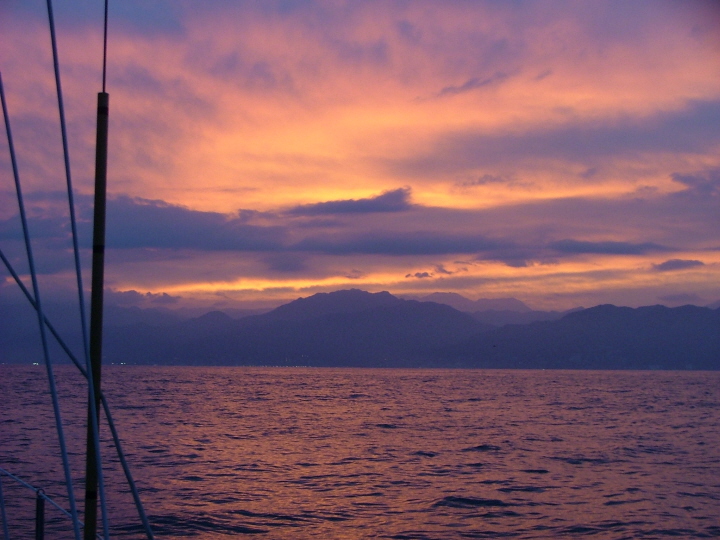
PUERTO VALLARTA

On the whole, we were fortunate on our run north to Puerto Vallarta [pwair-toe by-YAR-ta] as we had either south winds or no wind. Typically one gets wind out of the northwest on most of the Mexican coast except in the summer. Although we didn't have quite enough wind to sail at a respectable speed, at least we didn't have to pound into seas and headwinds.
We arrived in Banderas Bay very early in the morning after rounding Cabo Corrientes (Cape of Currents--aptly named) just after midnight. Motorsailing slowly toward PV, at the head of the bay, we were treated to this sunrise with the disappearing nightlights of the city strung along the shoreline.
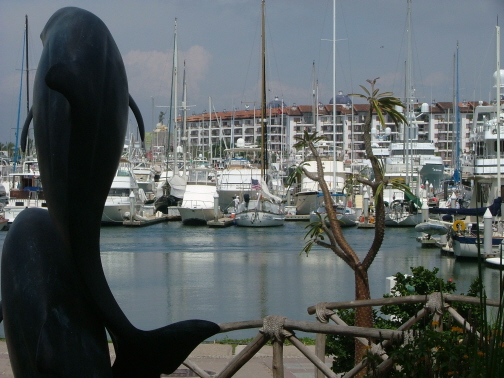
Coming in to PV harbor was like "old home week" for us. We had spent a couple of weeks here in April, 1991. But back then we had anchored out in the channel because our budget did not allow us to spend that much time in the then brand new Marina Vallarta. We are still on a limited budget but this time the gods smiled on us.
Just prior to leaving Zihuatenejo we made a last minute decision to go ashore an check our land-based email account one more time. We were certainly glad we did because we received an email from friend Gary Crowell reminding us that he still owned a condo moorage slip at Marina Vallarta. He informed us that it was currently unoccupied and available for our use as long as we needed it. Yahoo!! What a wonderful surprise.
Here's Kavenga in Gary's slip, E-27, Marina Vallarta. The marina is surrounded by condos, charter fishing offices, gift shops, and restaurants--so many of the latter that we were unable to try them all in the nearly two months we were there.
Gary's generosity made it possible for us to do things in PV that we wouldn't have even considered had it not been for the use of his slip. Many, many thanks, Gary.
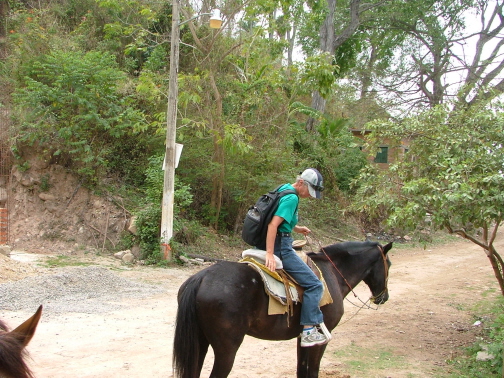
One of our first adventures after settling in at the marina was to go horseback riding. This was a somewhat momentous occasion in that it was the first time Kay had sat on a horse since having her leg broken by one in Redwoods National Park back in September.
We went to the same outfit that we had rode with in 1994, Rancho Ojo de Agua, and incredibly, Kay got the same horse she had ridden 11 years ago, Kaluha, a now19-year-old mare. Kaluha's a little slower now but still reliable on the many awkward river crossings we made. Steve rode a gelding named Gitano (Gypsy) who was obviously an "Alpha" horse in that he had to be in front.
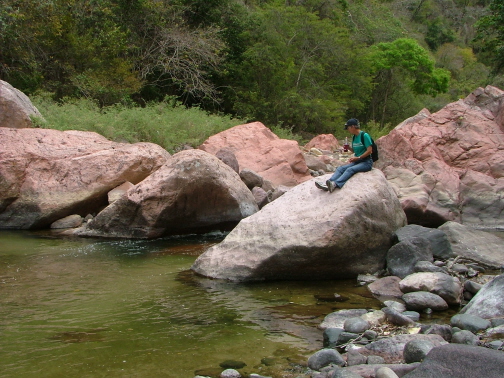
We started off on the ride with another dozen or so riders, but we had paid for a longer ride and half way up the river canyon the rest turned back with one of our two guides. We continued on up the jungle canyon, crossing the crystal clear stream perhaps 15 times before we finally came to a point where these large pink granite boulders blocked our way.
We took a 20-minute break before starting back down. Half way back to the rancho, we stopped at riverside restaurant for lunch. The parking lot consisted of hitching posts.
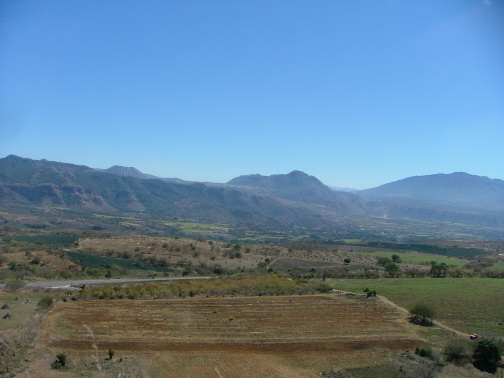
Based upon the recommendations of other cruisers we took a two-day bus tour to Guadalajara. About a five hour drive inland from PV.
We stopped for lunch at a roadside restaurant overlooking this valley. The town in the distance is called Tequila. You may have heard of it. Tequila is in the State of Jalisco, and all genuine Tequilia liquor comes only from Jalisco, although not all of it comes from the town of Tequila.
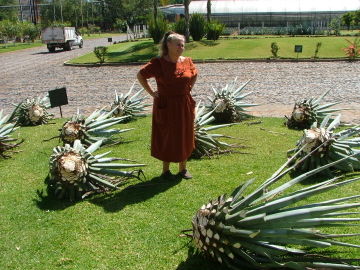
This our tour guide, Alfreda (a Canadian ex-pat), amidst a bunch of recently harvested Agave plants. She explained that the reason Tequila is more expensive to manufacture than grain-based liquors is that the the Agave plant cannot be harvested until it is at least eight years old.
Alfreda took us on a tour of one of the better Tequila distilleries, the Herradura distillery. Herradura is run like an old hacienda. The workers live in houses that are part of the hacienda and the distillery.
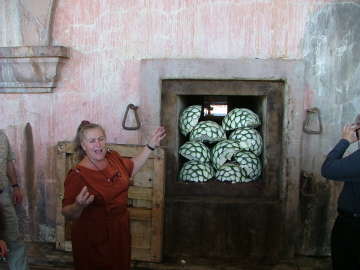
Alfreda told us that only the buds of the Agave plant are used to make Tequila. The bud is extremely starchy and thus full of natural sugars.
Here are a bunch of buds cut in half in one of the old ovens for display.
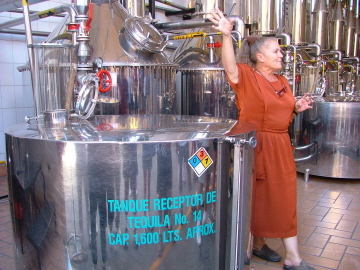
Alfreda is explaining that these distillation tanks contain "virgin" Tequila, Tequila that has not yet been diluted to the regulated strength of 80 proof or 40% alcohol. The virgin Tequila is 57% alcohol. She then gave all of us a few sips right out of the tank. Yikes! What a throat burner!
At the end of the tour we were privileged to taste the three classic versions of the final product, blanco (white or clear), Reposado (golden, aged in casks), and Anejo (aged for several years).
By the way, if the bottle's label doesn't say 100% Agave, the Mexicans considerate it inferior tequila.
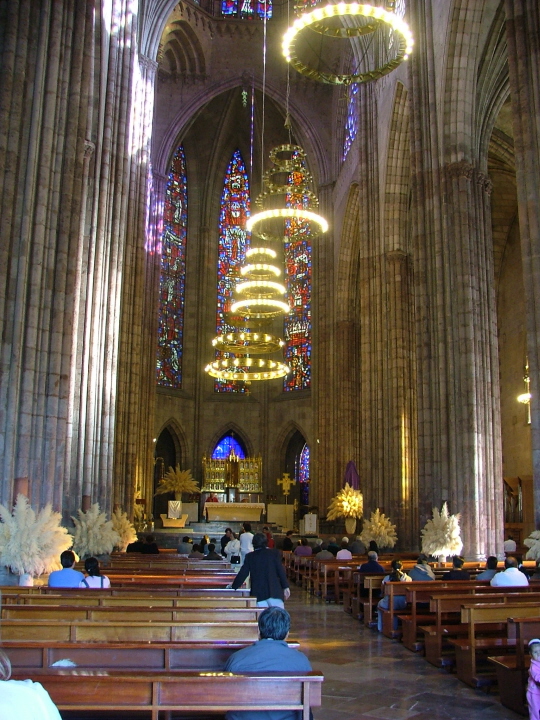
Guadalajara has many beautiful, Spanish colonial era cathedrals such as this one.
It is called the Templo de Expleotorio.
It has a clock tower on the outside and on the whole hour, Jesus comes out of one door, followed by his 12 disciples, and then disappears through a door on the other side.
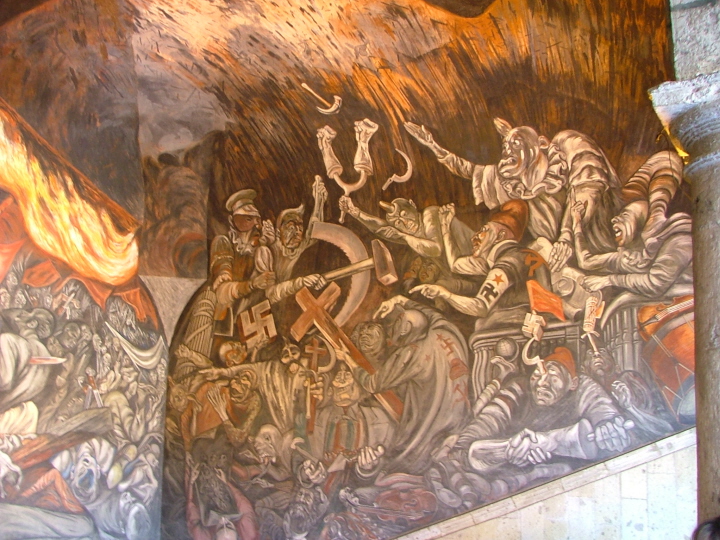
Alfreda took us to one of the Jalisco State legislature buildings in Guadalajara and used the murals by Orosco on the walls and ceilings to give us a condensed history of Mexican government from the Spanish Conquest to the present day.
This particular ceiling mural, however, was the artists view of how the world of his time was coming apart under the rulers of that time: Hitler, Stalin, Mussolini, etc.
The mural is rich with symbols like a child's picture puzzle. Alfreda explained much of it for us.
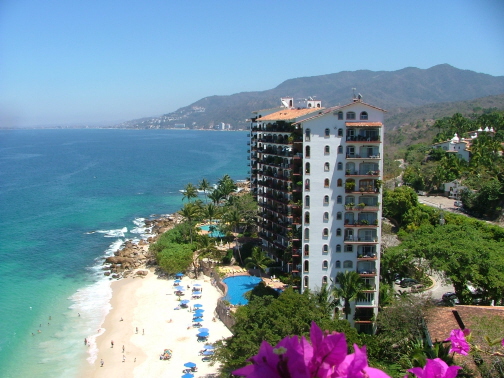
Looking toward Puerto Vallarta in the far distance from the Girasol Sur Condominiums on the south shore of Banderas Bay.
We went out to see Girasol after a visit from our Gig Harbor neighbor, Mark Learned. Mark and his wife, Gail, spend their winters here in their condo apartment. The view in all directions is gorgeous and they are blessed with the nicest beaches in Banderas Bay.
Life can be brutal sometimes.
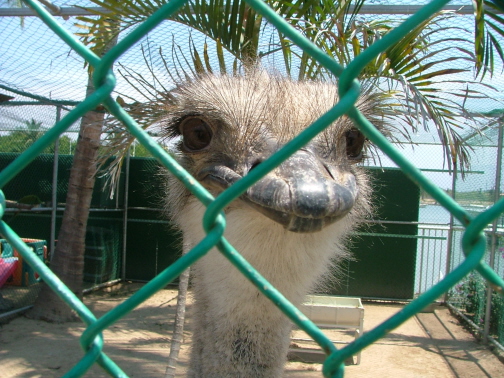
Many cruisers stopping in Banderas Bay opt to stay at the Paradise Village Marina in Nuevo Vallarta, rather than Marina Vallarta where we were. We went there for a visit one day. It's 15 minute bus ride north along the coast. We took Kavenga to Nuevo in 1991 but Paradise Village, a 5-start resort, did not exist then. In fact Nuevo Vallarta was a virtual ghost town and the dilapidated Nuevo Vallarta Marina appeared to be on its last legs.
Well, the Nuevo marina still looks that way, and if possible, it's in slightly worse condition now, but right across the lagoon is an incredible resort complex with new condo-hotels springing up all around it, and probably the best maintained yacht marina in Mexico.
Paradise Village even boasts its own zoo. We chose this curious fellow as their representative.
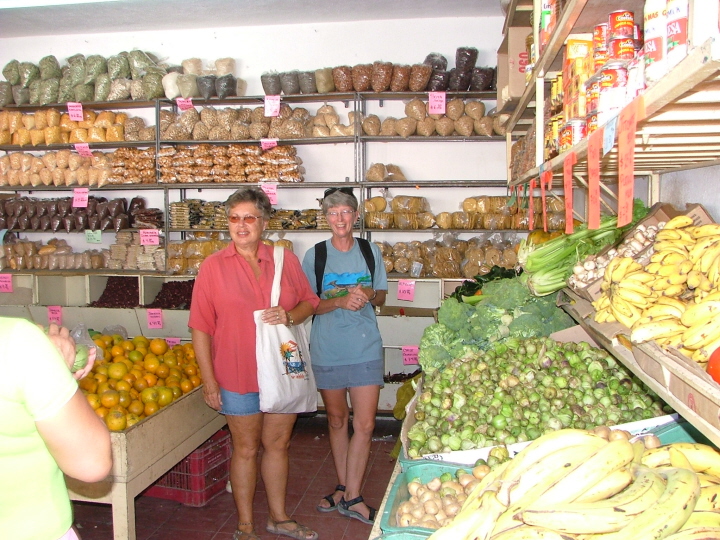
Here's Kay with Vickey of the Tartan 41, Snow White, shopping at a small public market in the PV suburb, Pittilal.
Vickey and her husband, Hugh, were our neighbors on E Dock, Marina Vallarta.
Just trying to figure out what some of the stuff is in these markets, is part of the fun of shopping in Mexico.
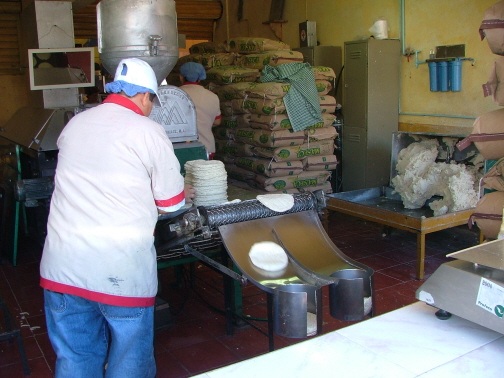
Ever wonder how tortillas are made? You will see machines like this one churning out tortillas in every significant town in Mexico.
The dough mixing machine is in the background.
The tortillas come out lightly baked, ready to bag and sell.
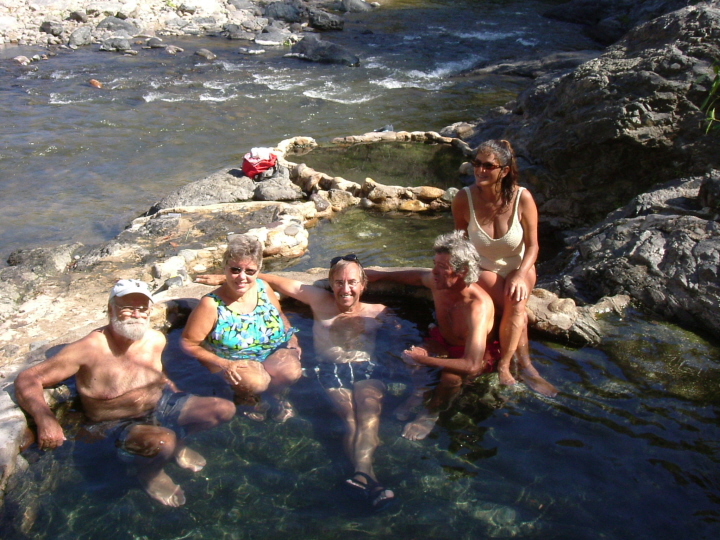
We took a couple of excursions out into the country. One was a hike to a waterfall (see picture on Home page). The other was a hike to this hot springs on the banks of the Rio Mascota, near the very small town of La Desembocada.
Here's Steve with Hugh and Vickey of Snow White (Redondo Beach, Ca.) on his right, and Bob and Dianna of White Swan (Port Townsend, Wa.) on his left.
The hot spring fed pools were about 105 degrees, while the river was about 70--a refreshing contrast.
Sadly, as it is often the case when cruising, we all went our separate ways a few weeks later; Hugh and Vickey back to Redondo Beach, and Bob and Dianna, to La Paz and the northern parts of the Sea of Cortez.